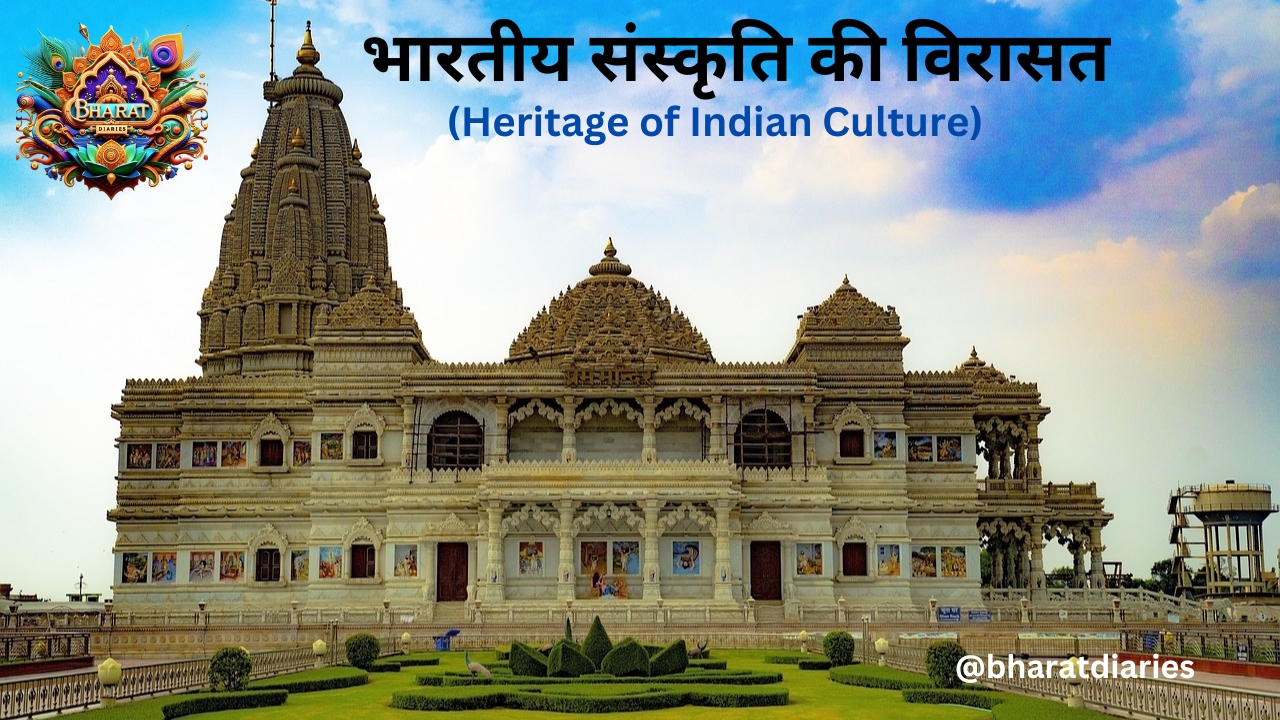
Dive into Indian cultural legacy with an in-depth exploration of its art forms, literature, and architecture from ancient to modern times. Perfect for UPSC aspirants!
Table of Contents
Introduction
India, a land of profound diversity, is home to one of the richest cultural heritages in the world. Indian Culture, encompassing millennia of artistic brilliance, literary genius, and architectural grandeur, reflects the soul of its people and their deep-rooted traditions. From the rock carvings of ancient temples to contemporary literature, from classical dance forms to modern architectural marvels, the cultural journey of India is both vast and inspiring.
This blog takes you on an immersive journey through the art forms, literature, and architecture of Indian Culture. Designed for UPSC aspirants and enthusiasts, this exploration highlights the key milestones of India’s cultural history and its continuing relevance today.
https://bharatdiaries.com/the-remarkable-journey-of-india/
1. The Evolution of Indian Art Forms
Ancient Art: Foundations of Indian Culture
Art in India dates back to prehistoric times, with the cave paintings of Bhimbetka providing glimpses into early human life and creativity. The seals and terracotta figurines of the Harappan civilization demonstrate the artistic finesse of one of the world’s earliest urban cultures.
- Examples: Bhimbetka Cave Paintings, Dancing Girl of Mohenjo-Daro, Harappan seals.
Classical Art: Spiritual Expression in Indian Culture
The classical era of Indian Culture saw art deeply intertwined with spirituality. The Mauryan and Gupta periods gave rise to Buddhist stupas like Sanchi and exquisite temple carvings. The frescoes of Ajanta and Ellora epitomize this era’s artistic sophistication, depicting religious narratives and scenes from daily life.
- Examples: Sanchi Stupa, Ajanta Caves, Chola bronzes.
Folk and Regional Art Forms
Indian Culture thrives in its folk and regional art traditions. Warli paintings of Maharashtra, Madhubani art of Bihar, and the vibrant Pattachitra art of Odisha are timeless expressions of rural creativity and cultural heritage. These forms often depict festivals, rituals, and nature, showcasing the deep connection between art and daily life in India.
- Examples: Warli art, Madhubani art, Pattachitra paintings.
Modern and Contemporary Indian Art
The modern era brought new dimensions to Indian Culture. Raja Ravi Varma’s iconic paintings blended Indian themes with European techniques, while artists like Jamini Roy and Amrita Sher-Gil created unique styles rooted in tradition but open to modern influences. Today, contemporary Indian art reflects global themes while staying deeply connected to its roots.
- Examples: Works by Raja Ravi Varma, Jamini Roy, Amrita Sher-Gil.
2. Indian Literature: A Journey Through Time
Ancient Literature: Foundations of Thought and Philosophy
The earliest expressions of Indian Culture in literature are the Vedas, which blend philosophy, hymns, and rituals. The epics Ramayana and Mahabharata are monumental works that go beyond storytelling, imparting moral lessons and exploring complex human emotions.
- Examples: Rigveda, Ramayana, Mahabharata.
Classical Literature: The Flourishing of Indian Culture
Classical Indian literature reached its zenith with poets and playwrights like Kalidasa, whose works such as Shakuntala and Meghaduta are celebrated for their lyrical beauty. Tamil Sangam literature, including Tirukkural, also thrived during this period, providing insights into life and values in ancient India.
- Examples: Works by Kalidasa, Tirukkural by Thiruvalluvar.
Bhakti Movement and Vernacular Literature
The medieval period of Indian Culture witnessed the rise of devotional literature during the Bhakti movement. Saints like Tulsidas, Kabir, and Mirabai wrote in vernacular languages, bringing spiritual teachings closer to the masses. Their works emphasized devotion, equality, and personal connection to the divine.
- Examples: Ramcharitmanas by Tulsidas, Bhakti poems by Mirabai, songs of Alvars and Nayanars.
Modern Indian Literature: Reform and National Identity
In the modern era, Indian literature became a powerful tool for social reform and the freedom struggle. Writers like Rabindranath Tagore, Munshi Premchand, and Subramania Bharati used their works to address social issues and inspire national pride. Post-independence, Indian literature continued to evolve, exploring themes of identity, modernity, and cultural continuity.
- Examples: Gitanjali by Tagore, works of Munshi Premchand, Subramania Bharati’s poems.
3. Indian Architecture: A Legacy of Grandeur
Ancient Architecture: A Testament to Indian Culture
Indian Culture’s architectural legacy begins with the planned cities of the Indus Valley Civilization, where structures like the Great Bath reveal advanced engineering. The Mauryan period introduced stupas, and the Gupta era saw the emergence of temple architecture, with intricate carvings and harmonious proportions.
- Examples: Sanchi Stupa, Brihadeeswarar Temple, Sun Temple (Modhera).
Temple Architecture: The Pinnacle of Indian Culture
Indian Culture’s devotion is beautifully reflected in its temples. The rock-cut temples of Mahabalipuram, the soaring gopurams of Tamil Nadu, and the intricately carved shrines of Khajuraho highlight the regional diversity of temple architecture in India.
- Examples: Meenakshi Temple (Madurai), Konark Sun Temple, Kailasa Temple (Ellora).
Regional Variations in Medieval India
Regional styles flourished during medieval times, reflecting the unique cultural identities of various regions. The Vijayanagara Empire left behind monumental structures in Hampi, while the Chalukyas and Hoysalas created intricately detailed temples that stand as masterpieces of Indian Culture.
- Examples: Virupaksha Temple (Hampi), Pattadakal Temples, Hoysaleswara Temple.
Modern Indian Architecture: Tradition Meets Innovation
Modern Indian architecture reflects a blend of traditional values and contemporary needs. Post-independence, architects like BV Doshi and Laurie Baker emphasized sustainable design, creating structures that remain true to Indian Culture while embracing modernity.
- Examples: Sabarmati Ashram, Lotus Temple (Delhi), IIM Ahmedabad.
Conclusion
Indian Culture, with its rich traditions in art, literature, and architecture, is a vibrant tapestry that connects the past with the present. Each period of history has left its mark, showcasing the creativity, resilience, and spiritual depth of the Indian people. For UPSC aspirants, understanding this cultural legacy is not only academically enriching but also a way to appreciate India’s profound heritage. By delving into this journey, one can truly grasp the essence of what makes Indian Culture unique and timeless.
